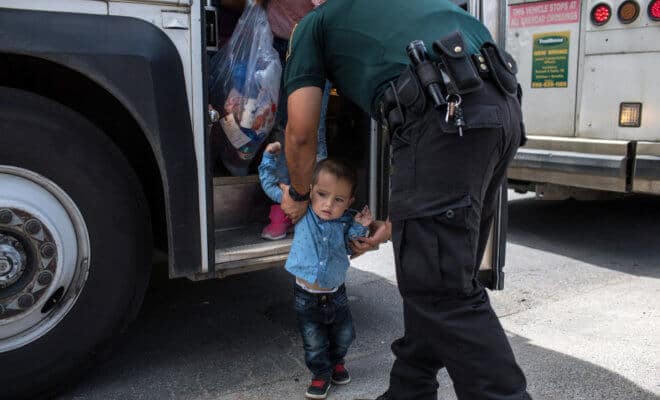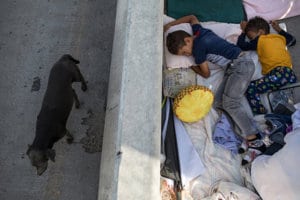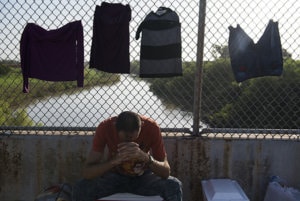Immigration
Trump Administration Considers Unprecedented Curbs on Asylum for Migrants

A 2-year-old boy from Honduras is helped off of a bus as he and his mother arrive at a bus station with other immigrants after being processed and released by U.S. Customs and Border Protection, in McAllen, Texas, June 24, 2018.
Photo: Tamir Kalifa/The New York Times
The changes are meant to send a clear message to the world: As a place of refuge, the United States is largely closed for business.
The kidnappings and mass killings were a fact of daily life for Francisco Miguel-Francisco, a young man living in Cerro Martín, a small village tucked into the indigenous highlands of Guatemala. He grew up in fear of the warring factions that battled for control of the region and that would kill without hesitation for a transgression as small as sharing food or water across enemy lines.
Fed up and desperate, he set out for the United States in 1984 and won asylum. He now lives in Arizona as a legal permanent resident with his daughter, who goes to a U.S. school and speaks unaccented English.
Three decades later, his son Miguel, who had been left behind in Guatemala, began his own journey away from a life that had become intolerable. Miguel reached Arizona on May 15, 2018, to a much different reception.
He was prosecuted and jailed for crossing the border without papers. His 15-year-old daughter, who had accompanied him, was shuttled to another state, and the family could not find her for more than a month. Miguel is still in immigration detention and his lawyer said he expects that he will soon be denied asylum and deported.
The divergent experiences of father and son, who traveled the same cross-continental route to salvation, say much about the U.S. asylum system, which is transforming under President Donald Trump. Both men fled from lawlessness and violence that, even if they had survived, would have threatened any hope of a stable life in their country.
But their experiences were viewed very differently in the United States. While migrants fleeing communist governments in Central America during the Cold War were welcomed in the 1980s, those arriving now do not fit into a larger U.S. geopolitical agenda. Their afflictions — gang violence, domestic brutality and poverty — are neither U.S. national security priorities nor anything that was originally intended to be covered under the laws of asylum.
Trump has taken monumental steps to shrink the asylum system and discourage people from applying based on a belief that the United States is taking in too many foreigners. The moves are part of a larger plan developing in Washington to reshape the reputation of the United States as a safe haven, one that has inspired generations of people like Francisco and Miguel to journey here.
The most extreme proposal yet would upend the system by eliminating the use of offices along the border, known as “ports of entry,” as asylum processing centers. Introduced this spring by members of the leadership of U.S. Customs and Border Protection, according to a government official with direct knowledge of the plan, it would allow hopeful refugees to apply for protection only from abroad, stranding them for much longer in the conditions they hope to escape.
On Wednesday, the administration announced new guidance for asylum officers, who are the first to evaluate claims along the border, instructing them to scrutinize asylum applications according to stricter standards and to weigh the applicants’ claims of fear against whether they have previously entered the United States illegally.
“Asylum was never meant to alleviate all problems — even all serious problems — that people face every day all over the world,” Attorney General Jeff Sessions said last month in announcing a landmark decision to eliminate domestic and gang violence as grounds for asylum.
Piggybacking on that announcement, Trump declared on Twitter that he wanted the power to immediately reject people who had no clear basis for asylum at the border before they could plead their cases in front of immigration judges.
“We cannot allow all of these people to invade our Country,” Trump wrote, “When somebody comes in, we must immediately, with no Judges or Court Cases, bring them back from where they came.”
Taken together, the changes are meant to send a clear message to the world: As a place of refuge, the United States is largely closed for business.

A family of asylum seekers from Honduras sleep on the Mexican side of the Brownsville Matamoros International Bridge where they waited, near Brownsville, Texas, June 24, 2018. Photo Credit: Tamir Kalifa/The New York Times
The modern asylum system was born during a time of clearly drawn political lines. After World War II, with the wounds of violent discrimination still fresh, the United States and its allies agreed at a United Nations convention in 1951 that accepting refugees was essential to preventing such atrocities in the future.
Albert Einstein became one of the original poster children, literally, for refugee resettlement after he was banned, along with all Jews, from academic work in Germany. Mikhail Baryshnikov and other Russian ballet dancers followed decades later when they were famously offered protection from Soviet oppression in the United States and Canada.
These cases were clear-cut in the public consciousness: These people were largely fleeing government persecution based on their race, religion, nationality or political views — four discrete categories for asylum under international law — and Republicans and Democrats mostly agreed on helping them.
That consensus has dissolved more recently with the expansion of a fifth, much murkier, category of refugees, which has ballooned to protect victims of modern threats coming from nongovernmental entities such as gangs and terrorist organizations. Recently, claims have also been recognized from gay and transgender people in countries that persecute them and female victims of domestic violence in places where the government refuses to protect them.
Trump’s administration is in the midst of a targeted push to turn back the clock.
“Asylum is for people fleeing persecution, not those searching for a better job, yet our broken system, with its debilitating court rulings, a crushing backlog and gaping loopholes, allows illegal migrants to get into our country anyway, and for whatever reason they want,” Homeland Security Secretary Kirstjen Nielsen told Congress in May. “This scamming of the system is unacceptable.”
More than 700,000 cases are now pending in U.S. immigration courts, with the largest numbers of people waiting from Mexico and Central America. The growing backlog, plus a shortage of judges, has steadily increased the wait time for asylum and other types of immigration cases, which now take nearly two years on average to complete, according to data maintained by Syracuse University.
One of the biggest blows to asylum petitions came last month when Sessions overruled the case of Aminta Cifuentes, a Guatemalan woman who suffered a decade of abuse by her husband that included acid burns and punches to her stomach when she was eight months pregnant. Her baby was born prematurely and came into the world with bruises.
Cifuentes’s lawyers argued that she was the victim of a larger crisis facing women in Central America. They presented a slew of reports by human rights groups as evidence that gender-based violence was a systemic problem that had been ignored by police and convinced a panel of judges that the existence of “a culture of machismo and family violence” in Guatemala meant that such women should be considered, for purposes of asylum claims, their own “particular social group.”
Similar claims had been approved in the past, at the discretion of individual judges. But after the Board of Immigration Appeals laid down precedent by granting Cifuentes asylum, women from all over the world began to apply in droves using the same argument. Though the government does not track the grounds of asylum cases, lawyers and judges said that domestic violence had become one of the most common arguments heard in immigration court — until it became a useless one last month with Sessions’ new guidance to judges.
“The mere fact that a country may have problems effectively policing certain crimes — such as domestic violence or gang violence — or that certain populations are more likely to be victims of crime, cannot itself establish an asylum claim,” said Sessions, who has the power to guide immigration judges on how to interpret the law.
Trump and his allies are also concerned about asylum fraud, as well as the large numbers of people whose claims are denied but who stay in the United States anyway, slipping into an unauthorized life in the shadows.
Of total asylum claims, which increased 1,700 percent between 2008 and 2016, Nielsen told Congress, only 20 percent of applications are finally approved by a judge. “So our concern is that there’s a lot of fraud,” she said.
She pointed to the ever-growing number of people who journey to the United States because they believe wrongly that the doors of asylum are open to anyone.
“It doesn’t mean that you made a fraudulent claim, it could just mean that you believe that you can seek asylum, for example, for family reunification,” she added. “But our laws don’t allow you to seek asylum for the sole purpose of family reunification.”

A Honduran man waits with fellow asylum seekers on the Mexican side of the Brownsville Matamoros International Bridge near Brownsville, Texas, June 28, 2018. Photo Credit: Callaghan O’Hare/The New York Times
At shelters along the southwest border, false hope is widespread, born of a combination of misinformation and wishful thinking. Asylum-seekers have been sleeping curled around their belongings on a piece of ground in Nogales that marks the last patch of Mexico, waiting to be interviewed by American officials.
In interviews with more than a dozen of these families over several days this month, most seemed to believe that if they attended their court hearings, they would be allowed to work and stay in the United States.
Several people indicated that while Trump may have been separating families in recent weeks, they ultimately had faith that his administration would offer them protection.
“This president is going to help me,” said one woman, Mary Montejo, 38, speaking from a shelter in Tucson, Arizona. “He’s going to help me. I believe in my God and I believe God has touched his heart.”
In Nogales, Gilberto González, 63, a Mexican security guard, was keeping watch over asylum-seekers. “This is painful to me,” he said. “They don’t know what faces them on the other side.”
Other ideas for restricting asylum are being batted around Washington, according to officials at the Department of Homeland Security who spoke on the condition of anonymity because they were not authorized to discuss them.
Beyond eliminating asylum at the border, proposals have been floated to further toughen the “credible fear” test, which is the first step to winning an asylum case. Another plan would keep applicants in detention, or take away their right to work, until their cases are resolved.
In the Miguel-Francisco family’s hometown, Cerro Martín, Guatemala, the threats lurking in the hills may be less pronounced today, but life there does not come without risk.
The area was once a stronghold for guerrillas during the civil war between leftists fighting for communism and a violent dictatorship that was willing to do anything to preserve its power.
Today, the village is undergoing a rapid transformation. Remittances sent back by people who fled during the war have sparked a construction boom, and the traditional mud houses with tin roofs are now flanked by multistory buildings with elaborate stained glass that look awkward and out of place.
People like Miguel who have family in the United States are particularly vulnerable to threats and extortion by gangs and cartels, which plague the city because of its location along the main route for trafficking humans and drugs into Mexico and on to the United States.
Since Miguel has been jailed, Francisco, his father, has taken on the care of his 15-year-old granddaughter, Katarina, as well as Miguel’s 18-year-old son, who came to the United States last year as an unaccompanied minor.
Both young people have their own asylum petitions pending. Children in his home country “suffered all the time,” Francisco said, adding that he saw no substantive difference between their predicament and the one that he ran from decades earlier.
“There was no way for them; the government didn’t provide them with any opportunity,” he said of the children. “That’s why they fled, not for any other reason than to save their lives.”
Julie Turkewitz and Sandra E. Garcia contributed reporting.
© 2018 New York Times News Service




You must be logged in to post a comment Login